Linkedin outreach stats have shown that 73% of buyers are more interested in what salespeople have to say if they reach out to them on LinkedIn.
If your sales team wants to generate more qualified sales leads per day, we suggest using the steps below that our LinkedIn lead generation agency uses.
This sales prospecting strategy gets the following results:
Since 2019, our clients have averaged a 19.98% reply rate with our ultra-personalized LinkedIn lead generation services.
And…
48.14% of those replies were either meeting requests or qualified sales inquiries on their product or service.
This guide will show you how to master this prospecting strategy and find more qualified leads that convert into sales.
(If you would like personalized prospecting advice, you could also hop on a free 15-minute strategy session with the founder of Salesbread, Jack Reamer.)
Consider this before you begin your prospecting process on LinkedIn
Use lead generation tools the right way
We suggest investing in certain prospecting tools and not just LinkedIn Sales Navigator.
Sales Nav is notoriously inaccurate when not used correctly.
The video below shares some hacks for using Sales Nav the right way.
Below are some LinkedIn Sales Navigator tips you can use:
Tip 1: Improving Keyword Search on LinkedIn
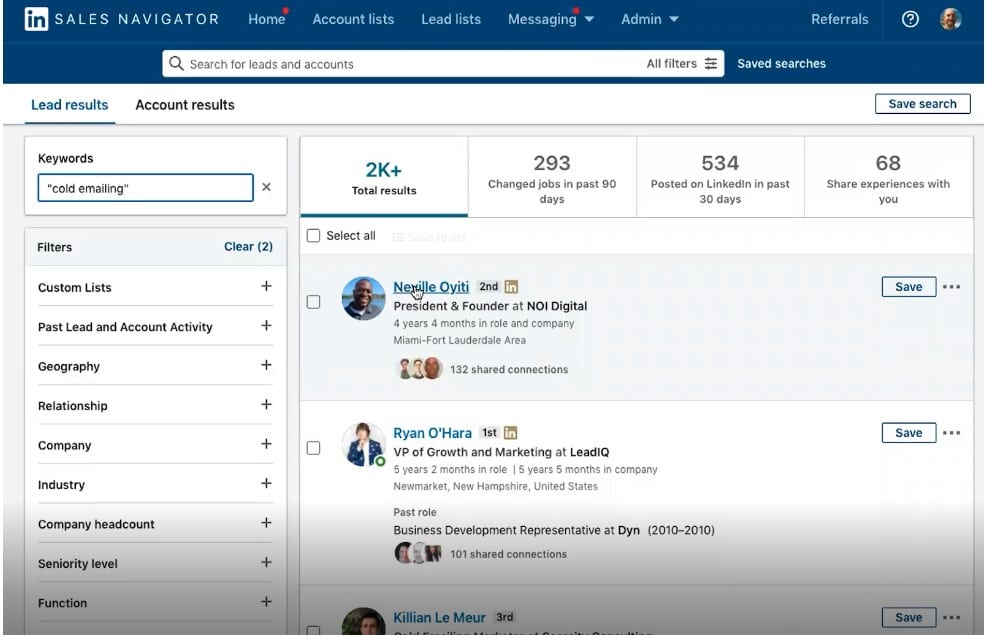
The tool for keyword searches on LinkedIn might not always give accurate results. For instance, if you use a keyword like “ cold emailing,” you’d expect it to pull up profiles specifically related to that.
But sometimes, it doesn’t work that way.
Instead, it might display profiles unrelated to the keyword.
This flaw limits the tool’s functionality within LinkedIn Sales Navigator.
However, there’s a clever workaround known as an “X-Ray or Boolean” search using Google.
Type in Googles URL: linkedin.com/in/ AND ‘ cold emailing” in the Google search bar.
Google’s indexing is more accurate because it scans and indexes all LinkedIn profiles.
This technique ensures 100% accuracy in finding profiles associated with your specified keyword.
Tip 2: How to hack the industry filter
The industry filter on LinkedIn might also lead to some false information.
Why?
Because users categorize themselves into industries, which can vary widely from person to person.
For instance, a health and wellness app might fall under both health/fitness and technology categories.
This is why we always go outside of Linkedin Sales Navigator and use third-party data providers such as:
-
Apollo.io
-
Crunchbase
-
Zoominfo
These tools provide comprehensive data, allowing precise targeting. You can then feed this list into LinkedIn Sales Navigator for more accurate targeting.
Tip 3: Leverage LinkedIn Groups
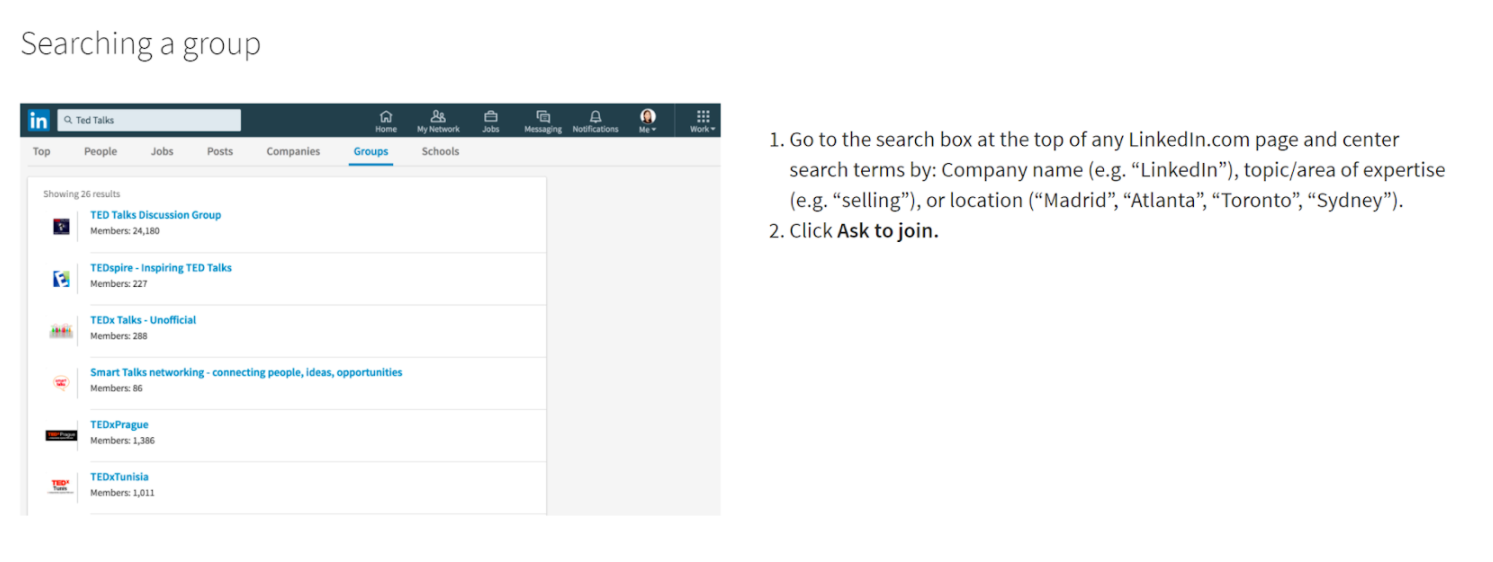
LinkedIn Groups serve as a goldmine for discovering potential clients within specific demographics.
For instance, you might be interested in reaching out to Christian marketers in Florida. You can filter through groups on Linkedin to engage with this group of individuals.
Engaging in these groups opens doors to specific markets that may not be easily accessible through regular searches.
Tip 4: Filter your prospecting list by your second-degree network and recently posted
After conducting a targeted search, filter the results through your second-degree network and recently posted.
Studies have shown that if a prospect is in your second-degree network, the chances of them connecting with you will be higher.
Why?
Because they have already accepted someone like you in the past. You already have mutual connections in common.
When you filter your list by recently posted, you are ensuring that you send LinkedIn messages to prospects who are actively engaged on LinkedIn, improving the chances of lead generation success.
Tip 5: Don’t use automation for the entire sales process
Some automation is helpful.
For example, at Salesbread we use Expandi to send follow-up messages, but when we reply, it’s always done by a human and not a bot.
The reason for this is that people can smell when a bot has sent an outreach message. Most of the time, users ignore these messages because they are impersonal.
Here’s a quick example:
I once received an email about a tool that I thought would be helpful. I replied to the email with a few questions about the tool.
Much to my disappointment a generic, automated email was sent back in return.
This was off-putting and I never pursued the product.
So, yes you can use automation tools, but make sure you don’t use them for your entire sales process.
Tip 6: Don’t just use InMail messages either
At Salesbread we make use of both Inmail and connection request messages. Inmails should be supplementary, and connection requests should be your main form of connection with new prospects.
As we mentioned above, prospects are more willing to connect with you when you share mutual connections.
Below are our metrics when sending connection requests :
%
Connection Request Acceptance Rate
%
Reply Rate
%
Positive Reply Ratio
Tip 7: Update your LinkedIn profile before considering outreach
Your LinkedIn profile is like a first impression. If it looks unprofessional, prospects might not be interested in engaging with you.
Make sure your information is up to date, and mention how your company solves specific pain points.
LinkedIn mentions how your profile photo should take up 60% of the frame and also make use of the LinkedIn banner.
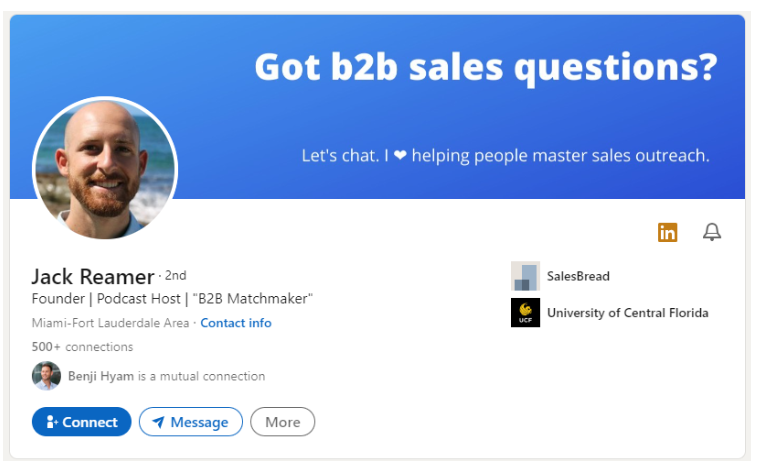
Make sure your contact details are also easy to see, so if a prospect would like to reach out to you, or view your website, they know exactly where to click.
Use this LinkedIn prospecting strategy for more qualified sales leads
Step 1: Build an ultra-refined list of prospects based on current buyers data
One common pitfall for B2B marketers is relying on overly broad prospect lists, leading to lead gen failure.
For instance, targeting a wide range of small healthcare businesses in America might seem appealing, because you might feel that you could get more results.
But because the list isn’t ultra-refined, you might end up with thousands of prospects who aren’t interested in what you’re selling.
Why?
Because they might not need what you’re selling, they might not have the budget, or you might be reaching out to individuals who don’t have the buying power.
This is why obsessing about list-building is imperative to prospecting success, especially on LinkedIn.
Look closely at businesses that have recently made purchases from you. Analyze their common traits by looking for patterns.
For example:
- Types of healthcare companies purchasing from you (e.g., hospitals, clinics, insurers)
- Geographical location (e.g., proximity to New York or specific regions)
- Company size (e.g., number of employees, annual revenue)
- Services provided and departments involved in decision-making
- Preferred CRM or automation tools and reliance on referrals
- Do they use social media in their marketing?
- Who is the decision maker? The CEO? Marketing manager?
By identifying these patterns, you can create hyper-targeted prospect lists, ensuring you approach B2B companies that really need what you’re selling and who have the budget.
(Read this case study to see exactly how we did this for a company called Ultrascope, and how we boosted their reply rate from 20 – 30% on LinkedIn.)
Step 2: Find the right people to reach out to at these accounts
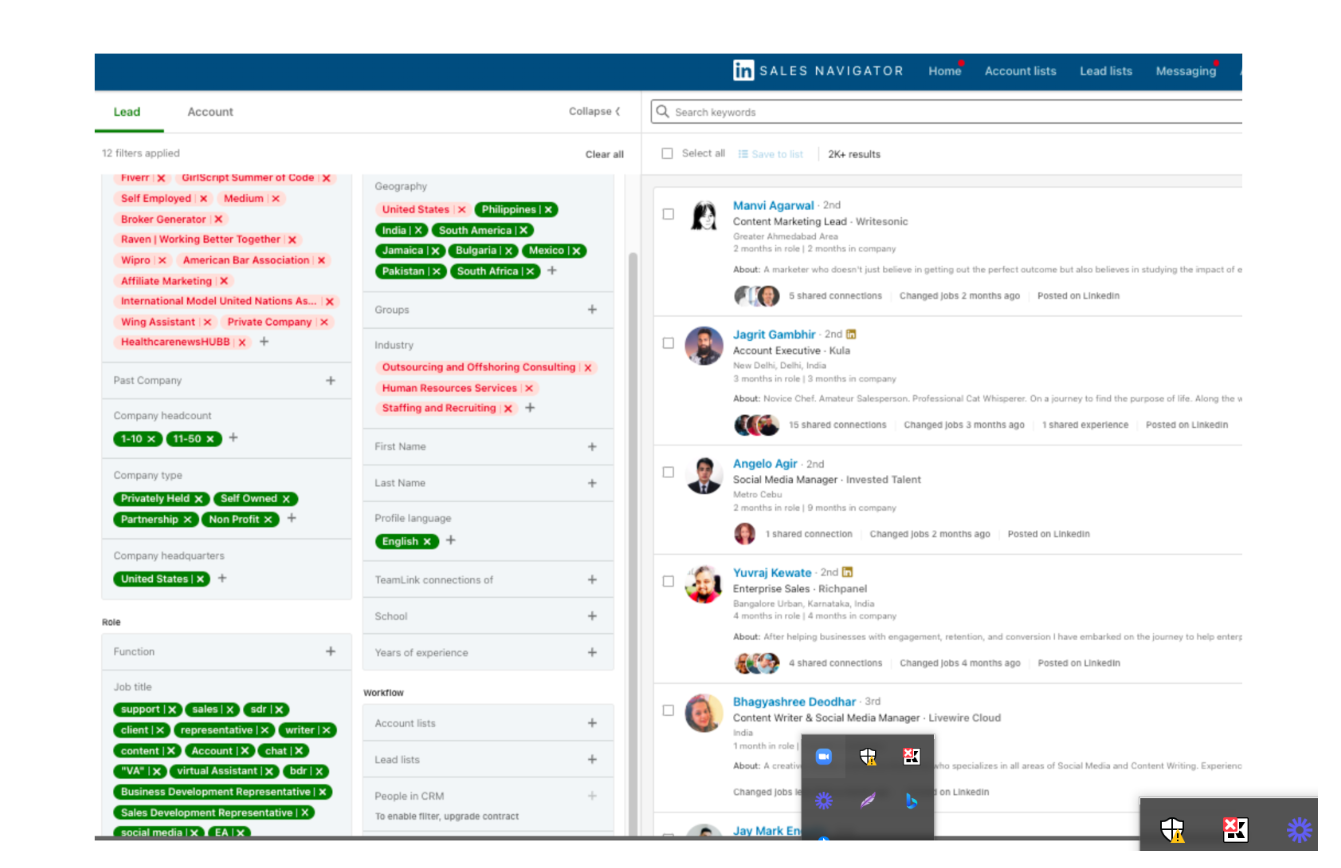
The next step is to plug your list into LinkedIn Sales Navigator and then filter prospects by your second-degree network and recently posted.
By refining your list even further, you will end up with the perfect ideal customer profile, meaning that the chances of lead generation success on LinkedIn will be so much higher.
Step 3: Research each prospect on the list and write a specific personalized message just for them
Researching each prospect on the list takes time, but it pays off.
When someone receives a specific message just for them, it cuts through the noise of all the other sales reps on Linkedin.
Have a look at each prospect’s profile and use our CCQ formula. (Compliment-Commonalities-Questions).
This means that you need to find something to either:
-
Compliment the prospect on
-
Mention a shared commonality
-
Or ask a question
The aim here is not a hard sell but to initiate a conversation that can lead to further discussions or a sales call.
Personalized LinkedIn connection request messages
Here are some LinkedIn prospecting messages for you to use:
1.Hey {{Name}}, since we’re both working in {{commercial real estate}} here in {{San Diego}}, I’d like to invite you to share my network here on LI.
2.{{Name}}, I’m looking to connect with like-minded professionals who are on the {{revenue-generating}} side of things. Let’s connect?
3.Hi {{Name}}, I’m looking to expand my network with fellow business owners in the {{HR Tech}} industry. Looking forward to learning more about what you do and see if there’s any way we can support each other.
4.Hi (Name) LinkedIn showed me your profile multiple times now, so I checked what you do. I really like your {{sales posts}} and would like to connect with you here.
5.Hey (Name) I hope your week is off to a great start, since we both work in the {{HR/Employee Experience}} field together, are you open to connecting?(My background is in employee retention, happy to share insights anytime.)
6.Listening to your podcast now & subscribed! Wanted to connect and say thank you for sharing your insights – I’m using them to help land a lead gen job. Cheers,{{Signature}}
7.{{Name}}, we’re looking for a {{law firm}} like yours to collaborate on an upcoming book. Would like to interview you based on your {{10}} years experience with {{AI law}}. Have 15 minutes to talk next week?
8.Hi {{Name}} I’m on a personal mission to connect with thought leaders in the {{B2B lead gen}} industry. I’m still relatively new to the field, but glad I found your {{podcast}}. Let’s connect?
9.Hoping to connect with a fellow {{hr director}}. If you’re looking to do some networking, I’m happy to introduce you to other HR professionals I know here on LI.
10.Hi (Name), saw your last {{corporate retreat}} in {{Chicago}}. Had a few {{travel management}} questions for you. Open to connecting and sharing a few insights?
Step 4: Follow up using the Fibonacci sequence

After the initial outreach, your sales team must follow up.
We suggest using the Fibonacci sequence AND using more personalization.
To keep leads engaged without overwhelming them, it’s often important to mix up your follow-up strategy.
At Salesbread, we love using the Fibonacci sequence for this.
The Fibonacci sequence is a series where each number is the sum of the two before it, starting from 0 and 1 (like 0, 1, 1, 2, 3, 5, 8, 13, and so on).
When it comes to sales, this sequence can help you time your follow-ups effectively. Instead of reaching out every day or week, you can space your follow-ups according to this pattern.
For instance, you might contact a lead on day one, then wait two days, then three days after that, and continue to increase the intervals.
This method allows for regular check-ins that aren’t too much, showing respect for the lead’s time while keeping your business in their thoughts. It helps build trust and spot leads that are genuinely interested in your offerings.
You can also switch up your methods, using emails, phone calls, or even sharing brief, engaging content like a one-minute demo video or a quick slide deck. Think of these as “teasers” to keep their interest piqued without revealing everything at once.
Avoid a sales pitch in your follow-up messages; instead, focus on continuing the conversation by asking relevant questions related to the prospect’s pain points that your company addresses.
We also always ask for a booked sales call.
Your “ask” could be as simple as saying:
-
Is this something that resonates with you? Can we hop on a quick call next week?
-
Send me your calendar link and I will book a slot for a quick chat
-
Are you free for a quick 10-minute call?
Frequently asked questions about LinkedIn sales prospecting
What is LinkedIn prospecting?
Think of LinkedIn prospecting like fishing in a big pond for a specific fish.
Imagine LinkedIn as that pond, filled with many different types of fish.
Now, when you’re prospecting on LinkedIn, you’re not just randomly casting your net.
Instead, you’re using special tools and techniques to find the specific fish you want—the ones that could be interested in what you have to offer.
It’s a bit like searching for potential customers or people who might be interested in your business or what you sell.
You use LinkedIn’s search features to find these people based on things like their job titles, the company they work for, or even their interests.
Once you’ve found them, you start a conversation with them, trying to build a connection or relationship.
So, LinkedIn prospecting is like searching for the right people in a professional network, reaching out to them, and starting conversations to see if there’s a possibility of working together or doing business.
What is the best prospecting tool for LinkedIn?
At SalesBread we love using some of the following tools:
(Here’s a full list of some of the best b2b lead generation tools to use; The article includes pricing, reviews, and what the tools are for.)
Should you use LinkedIn automation tools?
You can use LinkedIn automation tools but you have to use it the right way. If you don’t, you stand the chance of getting your account blocked. We suggest using tools such as Expndi and NOT Chrome extensions.
What is the best way to approach a prospect on LinkedIn?
Personalization, personalization, AND more personalization. When you approach someone on LinkedIn, leave out the sleazy sales pitch and remember to just start a conversation. Our CCQ method will help you to do this.
Don’t think about “what’s in it for me,” but rather think about how you can help your prospect. Personalization will also help your messages stand out from every other sales professional on the platform.
Is LinkedIn Premium worth it for prospecting?
A LinkedIn premium membership might be a good investment based on what you’re looking for.
With perks like sending more InMails, unlimited searches, and access to analytics, it can really boost your outreach, enhance your company’s visibility, and help with recruiting and career growth.
And if it doesn’t work out for you, you can always cancel your premium account whenever you want.
Why LinkedIn might lead to more qualified results compared to other platforms
1. Professional Environment
LinkedIn is like a business networking event. People here are often in the right mindset for business-related discussions and opportunities.
If you use LinkedIn in the way it was intended to be used, as a social platform for expanding your business, individuals will be more willing to talk to you. This is why we encourage salespeople who want to use LinkedIn to be social and NOT salesy.
People on the platform already have the “business” mindset.
If you as a salesperson keep thinking: “How can I really help this individual with their pain points .” You’re going to win at prospecting on LinkedIn.
2. Targeted Search Tools
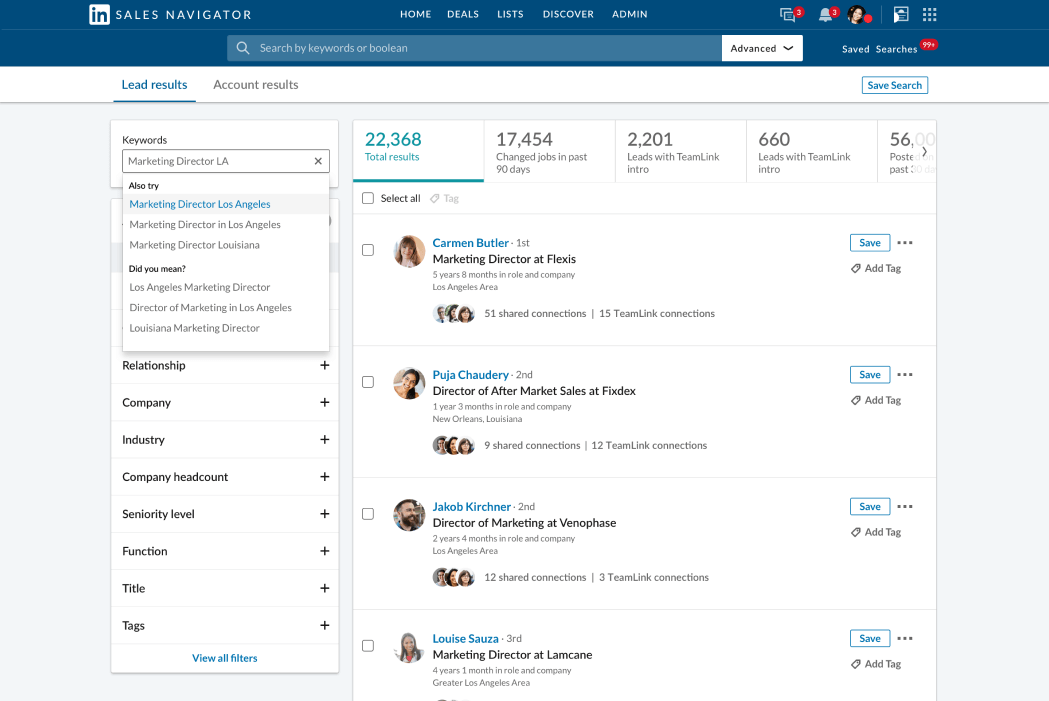
When using LinkedIn as a platform for cold outreach, you have access to specialized tools.
For example: Linkedin Sales Navigator
For example, if you pay $99 a month you can use LinkedIn Sales Navigator.
This tool allows you to use various search filters such as:
-
Job title
-
Industry
-
Company size
-
Company name
-
Geographics
-
Linkedin groups
There are also advanced search features to help you find the right people to connect with on the platform. (This makes it easier to find exactly the kind of leads you’re looking for.)
Just a word of caution… LinkedIn Sales Navigator has been shown to be inaccurate if you don’t know how to use it the right way.
The video below goes into more detail:
3. High-Quality Connections:
The users on LinkedIn are a gold mine of professionals, decision-makers, and influencers. So, the connections you make here often hold more weight and potential for business.
As we mentioned earlier, we manage to get our clients 1 quality sales lead per day by using LinkedIn outreach.
You can also get really granular with your prospecting lists which will ensure that you reach out to the right target audience, which in turn will lead to more sales.
4. Better Conversion Rates:
Studies have shown that LinkedIn has a higher visitor-to-lead conversion rate (2.74%) than Twitter (0.69%) and Facebook (0.77%).
That means more of the people you interact with on LinkedIn could potentially become leads for your business if you use the right
5. Lead Nurturing Opportunities:
LinkedIn allows you to build relationships over time. You can engage with prospects by sharing valuable content, participating in groups, or even commenting on their posts, all of which can help nurture your potential prospects.
6. Trust and Credibility:
People tend to trust LinkedIn more for professional networking. Building connections here can lead to stronger relationships based on trust and credibility.
If you have a strong presence on the platform as a thought leader in your industry, LinkedIn users will see your posts over and over again.
This in turn might move them to reach out to you when they need a specific service/product.
In conclusion
Today’s approach to finding leads on LinkedIn is about building connections, being social and not salesy, finding opportunities, and using the platform’s tools smartly for successful business growth.
If you’re interested in trying this LinkedIn prospecting strategy, why not hop on a free 15-minute strategy session with the founder of SalesBread? We would love to help you crush your business goals.
